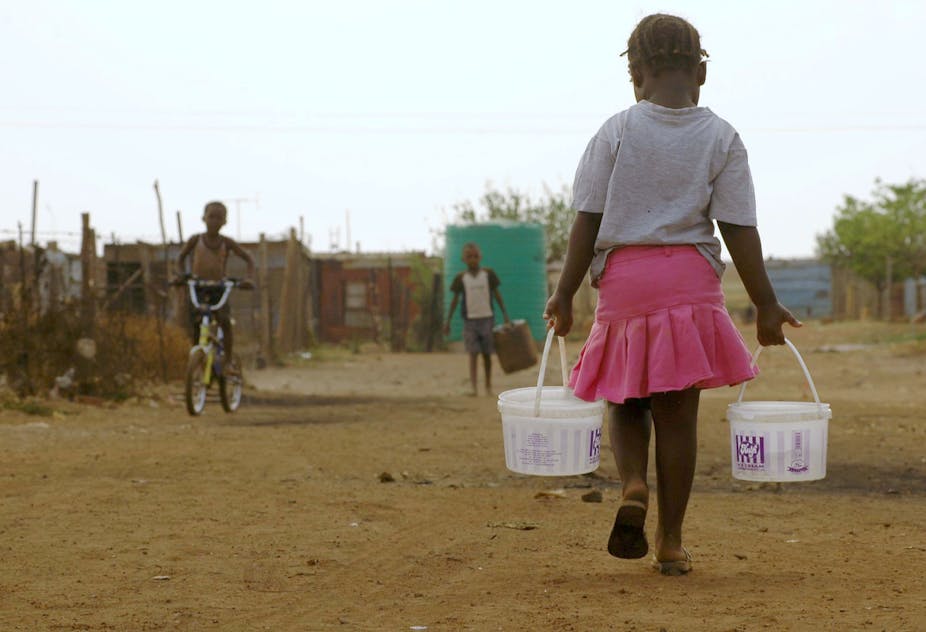Typhoid remains a risk in a number of African countries. The Conversation Africa’s editor Caroline Southey asked Lucille Blumberg, deputy director of the South Africa’s National Institute of Communicable Diseases, about typhoid fever.
What is typhoid and how would I know I’ve got it?
Typhoid is an illness caused by infection with a specific bacteria called Salmonella typhi. It has its origins in humans, not animals. It is found in the faeces of infected persons and spreads to others through faecal contamination of food and water. This occurs in situations where there is poor hygiene related to food preparation, where there is poor sanitation with inadequate ablution facilities and where drinking water is drawn from informal water sources. Hand hygiene after ablutions and before food preparation are critical in preventing the transmission of the bacteria to other people.
The danger with typhoid is that the symptoms are quite insidious, not specific, and mimic those of other infectious diseases. Symptoms include fever, headache, abdominal pain, cold shivers, hot sweats and loss of appetite. Symptoms usually increase over a number of days.
Importantly the symptoms are not specific and overlap with other infectious diseases like malaria, tick bite fever and meningitis. Malaria is the number one infectious disease to be considered when someone presents with a high fever because it really needs emergency treatment. But the possibility of typhoid needs to be considered in any patient who presents a high fever, particularly in areas where typhoid is more prevalent or where there are concerns about sanitation and water.
How do you get it?
Typhoid is transmitted through handling food and water if there is poor hygiene or poor sanitation. The most obvious source is where ablution facilities and drinking water are not separate and where water and sanitation is inadequate. The best protection against it is to wash your hands after going to the bathroom. And to avoid fresh produce from areas known to have cases of typhoid. Informal water sources for drinking should be avoided, or alternatively the water should be boiled before drinking.
How prevalent is it?
Typhoid affects about 21.5 million people a year, nearly all living in developing countries. It is endemic to Africa, South East Asia and South America, occurring all the time though there is much less of it now than 30 years ago. In Africa there are several thousand cases every year.
There is always a higher risk in places where the quality of water is poor and where sanitation isn’t optimal. There have been large-scale outbreaks in South Africa and Zimbabwe. Contaminated water was identified as the reason. A small town called Delmas in the north east of the South Africa’s Mpumalanga province experienced a number of large outbreaks of typhoid fever in 1995 and 2005 but no outbreaks have been reported since Rand Water took over the domestic water supply. There was an outbreak in Zimbabwe’s capital Harare in 2012 which is ongoing with 4000 cases having been diagnosed to date. A number of South African cases have over time been linked to this outbreak.
Typhoid is a notifiable disease. This allows the origin of cases to be investigated and also that authorities can be alerted if there is an increase in cases. In addition, the National Institute for Communicable Diseases in South Africa has a laboratory-based monitoring system. This includes monitoring for antibiotic resistance.
In South Africa an alert was put out when four cases were reported over a two-week period in the greater Johannesburg area. This was a little higher than usual and prompted a follow up investigation, especially given that one of the patients died.
Is there a cure?
In the pre-antibiotic era, people were terrified of getting typhoid fever. Then it carried a mortality of 5% to 20%. But today it is treatable. Antibiotics can be used although there are resistant strains in certain parts of the world.
It is something that needs to be treated early although it doesn’t carry the same high risk as malaria.
You need to get quite a high dose of the bacteria to become infected. And it’s not that easily transmitted. For example, you can’t get it by being next to somebody. You only get it if you eat or drink something that’s been contaminated.
But in situations where sanitation conditions are poor, and where fresh water isn’t available it can spread very quickly. That’s why there’s always the fear of an epidemic.
We are nowhere near such a situation now. The response to the one death in Johannesburg was prompted by media reports and we wanted to pre-empt concerns people might have. As the institute we get reports of between 110 and 120 cases of typhoid in the country a year.
A vaccine is available and can be considered for travellers to high risk areas, but the vaccine efficacy is only around 70%.

